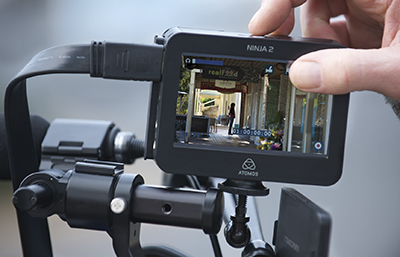Atomos Ninja 2 HD Field Recorder

Atomos Ninja-2CENTER VALLEY, PA. — Australia’s Atomos Ninja 2 is a high-definition field recorder and monitor that’s compatible with both PC and Mac platforms. Using the Ninja 2 is as simple as connecting your camera to the recorder/monitor via an HDMI cable. You can record uncompressed 10-bit HD or SD footage and export Avid DNxHD or Apple ProRes files for editing. I’m not sure that it gets any easier than this.
FEATURES
The Atomos Ninja 2 follows on the heels of its precursor, the Ninja, which came out several years ago. While there are some similarities between the units, the “2” has several features and does several things its older sibling didn’t include. These include an Avid DNxHD codec; HDMI output; higher screen resolution; monitor displays that include false color, peaking, blue-only, zebra and Smartlog; 3:2 pulldown removal, ExFAT file format to enable storage of larger files, HDMI timecode, and D-Tap adapter support.
The Ninja 2 is contained in a small, durable carrying case and comes complete with monitor and housing, two NP-F570 7.4-volt Lithium-Ion batteries (other batteries are available), a PN201 dual-port battery charger, USB cables and an AC power supply with three plugs for international use.
I should point out that there are, however, a couple of critical items that are not supplied and must be ordered separately.
These are the hard drive and HDMI cable. Obviously an HDMI cable is readily available from other sources, but the hard drive necessary to use the unit may require a bit more shopping. I was able to obtain a 500 GB hard drive from a local video dealer. Atomos does not supply drives, so check with your local reseller.
While several video cameras/camcorders provide an HDMI port for recording uncompressed, high-definition footage, only a few DSLRs offer this. I am aware of two Nikon units that are on uncompressed speaking terms with the Ninja 2: the Nikon D800 (36 megapixels) and the D4 (16 megapixels). I used the Nikon D4 for this review.
The main Ninja unit itself weighs in at slightly less than a pound without the wafer-thin hard drive and batteries. These bring the total weight figure up by another pound (less than two pounds total).
The unit is constructed of lightweight aircraft-grade aluminum, so the low weight doesn’t mean it’s not durable. It’s not particularly power-hungry either— the recorder I tested operated for as long as 10 hours with both batteries attached.
The 16:9 image on the monitor’s 800 x 480 screen is not as sharp as most DSLR LCD screens, but considering that when you attach an HDMI cable from your DSLR to the Ninja 2 monitor, the camera’s LCD screen does not de-activate like it normally would when you attach an external monitor.
The side of the monitor contains an HDMI input/output, allowing as many as three monitors to be operated simultaneously (more on this later).
There’s also a mini stereo “line in” and a mini output port for headphones located on the same side as the HDMI ports.
The top and bottom of the monitor include a female thread insert for mounting. Other items on the case include the unit’s power button and internal hard drive release. (The removable 2.5 inch HDD slides easily into the monitor and may be removed and inserted into one of two included workstations that have both USB and Firewire 800 ports.)
Your files can be recorded in 1080/60i, 1080/50i, 1080/30p, 1080/25p, 1080/24p, 720/60p, 720/50p, 480i and 576i. Realtime 1920 x 1080 encoding is a fast 220 Mbps in HQ mode, 150 Mbps in 422 mode, and 100 Mbps in LT in the Apple Pro Res mode. The speeds will be relatively similar in Avid’s DNxHD mode.
When you crunch the numbers, this is between 5 and 11 hours of footage on a 500 GB drive, 2.5 to 5.5 hours on a 250 GB drive; and from 10 to 22 hours on a one TB drive.
Supported editing programs include Final Cut Pro 7 and X; Avid’s Media Composer 5.0; Adobe Premiere 5.5; Vegas Pro 10; and Lightworks.
IN USE
I first tested the Ninja 2 in a cinematography class that I teach. We were using a Nikon D4 DSLR to capture a four-and-a-half- minute dolly shot. Beginning with a long shot, then slowing dollying 30 feet and finally ending up with a close-up shot, the crew had quite a task ahead of them.
The D4 was attached to the Ninja 2 via an HDMI cable and the loopthrough was used to connect to another monitor with a second HDMI cable.
I powered up the Ninja 2 via the touchscreen and activated the monitor function so that I could use the unit as an external monitor. Pressing the record control started the time code and I could see everything that was displayed on the Nikon’s LCD screen.
The camera operator and focus viewed the action via the camera’s LCD and I walked alongside the dolly rig holding the Ninja 2. Once the scene was completed I pressed “stop” on the screen and was immediately able to view the footage we’d captured.
The Ninja 2 gave each take a shot number that was recorded by our second assistant camera operator. (One minor drawback with the Ninja 2’s playback is that you must go through several menu screens until you locate what you’re looking for and your finger must press the QuickTime icon exactly dead center in order to select that shot.)
When viewing the footage immediately after recording, you can scrub through the “timeline,” with fast forward and rewind commands and basically do anything a NLE can do in addition to zebra and numerous other features.
After we were satisfied with the shoot I slipped the HDD into one of the caddies and connected it to my Final Cut Pro system via Firewire. I also took the CF card from the Nikon and imported that footage.
I could see no discernable difference in quality between what was recorded on the camera’s CF card and that recorded on the Ninja 2.
There are two different ways of looking at the Ninja 2. One is that it is an excellent, high-quality way of capturing all of your footage in the studio or on location. Our batteries never wavered and we had the Ninja 2 on constantly. The 500 GB drive is large enough to shoot a sizable project and is a lot easier than keeping track of a handful of 16 GB CF or SD cards.
The other option is using the Ninja 2 as a backup recorder, as I did in connection with the Nikon’s internal capture. If part of the production crew needs to play back a scene while the camera operators are setting up for the next shot, no problem; the Ninja 2 gives you the freedom to do this.
SUMMARY
I really had no issues with the Ninja 2, and after a while its use became second nature. Editing footage is as easy as hooking it up to your computer. I should note that there are many features the Ninja 2 possesses that I didn’t have space to cover here, for example, portability is one of its greatest features.
Also the Ninja 2 is an economical way to store captured content when you consider that the cost of a 128 GB CF card approaches $600. For less than $1,000, you have four times the card’s storage capacity and an external monitor to boot.
If you’re looking for a portable hard drive-based recorder for handling your studio, field and editing needs, you really can’t find a better solution than the Ninja 2.
Chuck Gloman is chair and associate professor of the TV and film department at DeSales University. He may be contacted atchuck.gloman@desales.edu.
FAST FACTS
APPLICATION
Capturing, monitoring and exporting location footage
KEY FEATURES
Large storage capacity, very reasonable price Portable hard drive recording utilizing a touch screen monitor; a large storage capacity, and easy transfer of footage in post.
PRICE
MSRP: $695
CONTACT
Atomos
503-388-3236
www.atomos.com
Get the TV Tech Newsletter
The professional video industry's #1 source for news, trends and product and tech information. Sign up below.
Chuck Gloman is Associate Professor with the TV/Film Department at DeSales University.

